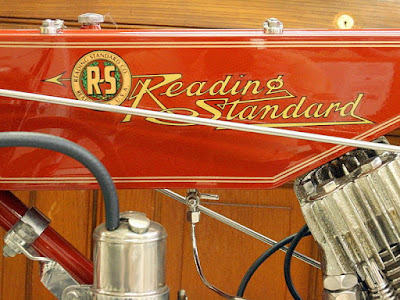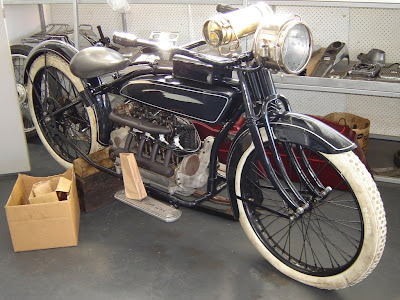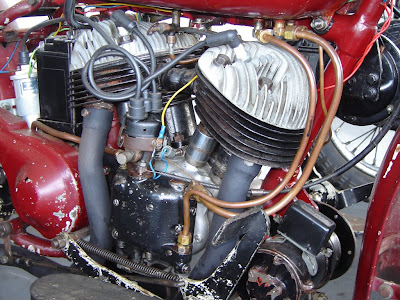 Description (revised)
Description (revised)Scootshop
Visit my eBay Store:Scootshop
This Motor has been in my family for as long as I can remember. The Motor turns free and is complete. Not sure the last time it was run or if it runs now. Engine sold AS IS. I found a few references of past sales one was in Nov 2006 at Bonhmas sale #14037 lot #402 sold for $4,388 another was also in 2006 at Centreville Antique Market I copied a bit from the markets website. "One dealer wearing a big smile Sunday afternoon was B.J. Pawlaczyk, who specializes in restored vintage outboard motors and accessories. He sold a refurbished 1929 Indian Silver Arrow 10 horsepower motor and stand for $6,000. The classic boating piece was made by the same company that manufactured the well known and highly sought after Indian Motorcyles from Springfield, Mass. He said the buyer, James Geachow of Bronson, Mich., had looked over his vintage motors in the past and “decided it was time to buy.”" Most outboard motor collectors value the Indian because only about 1500 motors were ever produced in 1930. Research has determined that there were two year models produced, the 1930 model has a cast aluminum gasoline tank with two brackets attached between the front of the tank and the top of each cylinder jug. An aluminum "Indian" nameplate was pinned to the back of the tank. The 1931 model was a newer version that had a two-piece pressed aluminum gasoline tank with a wrap-a-round "Indian" decal on the back which included starting and lubrication instructions. Indian Motocycle Company apparently stopped production of the outboards in August of 1930 per instructions of then President du Pont. The last Indian that sold on eBay went for a Buy-it-Now price of $4,500 to a motorcycle collector. The motor was in poor shape and was missing a number of critical parts. Another Indian outboard, which was completely over-polished and looked like chrome, was sold at an antique mall for $7,500. The Outboard will be crated and shipped by Forward Air. I will have a professional build the crate, Shipping to Anywhere in the Lower 48 will be $150.
On Mar-03-09 at 11:50:57 PST, seller added the following information:
I noticed that the carb body has a damaged screw on it. I have been E mailing someone very helpful from the www.aomci.org/ This is part of his E mail to me. After looking again at your photos, it appears that the only broken part on that throttle side of the carb is the lever. Those are available from hundreds of motors and are very easy to find. Muncie Neptunes made a lot of motors that use the same throttle lever or one that is very close, but beefed up a little which is actually an improvement. Evinrude, Lockwood, and Caille used similar levers. I see no real issues with your motor. It appears to be complete and in excellent condition for a 79 year old outboard motor. It is an extremely nice example of the 1930 Indian. P. S. Reproduction grips exactly like the one on your motor are available for about $15. I couldn’t remember all of your questions and realized that I overlooked some when I went back to your first email. Your Dad and his Uncle were correct. The motor is too darn heavy, and for the most part, they never ran well. That fancy muffler caused exhaust back pressure issues. The only way it would run decent was to run it with the exhaust cutout in the open position. Unfortunately, the cutoff faces into the boat and will quickly deafen the skipper and crew. Many motors are found with holes drilled in the muffler between the ribs. My D0 1002 has six holes in it. Some motors have had as many as 20 drilled in them. One guy actually has a motor where a big vacturi with a choke like plate was installed to relieve the pressure. This was a very common problem with the Indians. THE MOTOR FOR SALE HAS NO HOLES DRILLED IN IT. IT IS THE WAY IT LEFT THE FACTORY. Because many of the carburetors had too much lead content in their aluminum castings, many of them crumbled apart with age. This is not an uncommon problem and someone can usually figure out a way to repair it. At worst, there were some unmarked carburetor castings at that time which were the same as the MS-20D, but did not have the internal parts installed. Therefore, if one is found, the parts can be transferred to the replacement casting and then it can be marked as MS-20D with steel stamps much like the ones used for the serial number. Also, a number of Indians have turned up with other carburetors from a number of other motors built in the late 1920’s and early 1930’s. For your purposes, disclose that the screw mountings are damaged and leave it at that. Say that you do not know about the availability of parts, and then have them contact someone in the Antique Outboard Motor Club, Inc., like me. It is an issue that will have no bearing on your sale if someone wants an Indian outboard. So, don’t worry about it. Regardless, the new owner can worry about finding replacements or repairing the old carb. The main thing I saw that was excellent on your outboard was that the choke lever and the quadrant that says “choke” and “run” are both on your carburetor, as well as the air horn. Usually the horn is missing or the choke quadrant and lever are broken. If the throttle lever or quadrant that says “run” and “stop” are broken, there are a lot of old motors that had the same parts on them. They are easy to find unlike the choke parts. If the air horn is missing on any given motor, so is the choke lever and quadrant. Although other motors had the same air horn, there were much fewer of them that the throttle parts available. Carburetor castings stamped MS-20D were extremely rare. You are in excellent shape as far as the choke goes. Another thing that looks fabulous is the nameplate. I cannot see it all that clearly because you reduced the photos for email and eBay. If you send some of the photos again at their original size, it would make details easier for me to see (you can only send three or four at a time, but they come out much better on this end). From what I am able to see, the motor is really in good condition. I do not think you will have a problem getting a good price for it. There was a guy on eBay a few years ago that listed some “Indian Silver Arrow” signs for sale for $1,000 each. I had to tell him that he had nameplates for the outboard and not signs for the Indian Silver Arrow motorcycle made in the late 1940’s. He sold three and had one left (see photo attached). He told me he would sell it to me for $875. Needless to say, I do not have a nameplate for the back of mine yet. There are some reproductions available, but there are not as good as the originals. I doubt that I would ever pay more than a few hundred for the nameplate, but after seeing yours, I’m weakening. I HAVE GOTTEN GREAT HELP FROM THE memberservices@aomci.org I WOULD RECOMMEND ANYONE WITH A INTEREST IN OUTBOARDS CHECK EM OUT. www.aomci.org/
 Reading Standard (1903-1923) motorcycles were often advertised as "R-S" motorcycles. They were manufactured in a facility on River Street in Reading, Pennsylvania.
Reading Standard (1903-1923) motorcycles were often advertised as "R-S" motorcycles. They were manufactured in a facility on River Street in Reading, Pennsylvania.1903 — The Reading Standard brand first appeared. Those first bikes were basically Indian clones with Thor engines. They put out more motorcycles than Harley-Davidson and Indian.
1906 — They started building their own one-cylinder engines. These were the first flathead motorcycle engines offered by an American manufacturer. The company slogan "Built and Tested in the Mountains" was adopted when a Reading Standard motorcycle was the first motorized vehicle to climb Pike's Peak.
1907 — Reading Standard began racing. That same year they won their first 1,000-mile endurance race.
1908 — The first Reading Standard V-twin came out in the 1908 models. The first V-twins had conventional F-head configurations — overhead intake valve and side exhaust valve. What was really weird was the valve positions: the front cylinder had the valves on the left side, while the rear cylinder had the valves on the right side. These engines had 722 cc (44 cubic inches) displacement.
1910 — Reading Standard got out of the racing business and began to direct their attention to retail sales.
1913 — I've been unable to determine exactly what year the changes took place, but by 1913 the engines had grown to 990 cc (60 cubic inches). The bigger V-twins were flatheads. Some of the later models displaced 1180 cc (72 cubic inches).
1914 — Business was starting to go downhill.
1922 — Reading Standard sold out to the Cleveland Motorcycle Company.
1923 — Cleveland put out a 1923 Reading Standard as a low-price alternative to their own motorcycles.
1924 — The Cleveland Motorcycle Company itself went up for sale and the Reading Standard name disappeared forever.
20090917_0150-1a1_800x600



0 comments:
Post a Comment